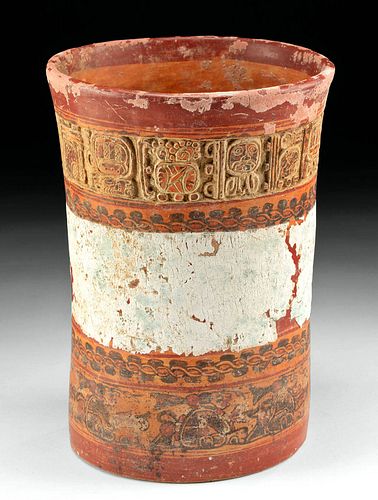Translated Maya Copador Cylinder w/ Stucco, TL'd
About Seller
686 S Taylor Ave, Ste 106
Louisville, CO 80027
United States
Selling antiquities, ancient and ethnographic art online since 1993, Artemis Gallery specializes in Classical Antiquities (Egyptian, Greek, Roman, Near Eastern), Asian, Pre-Columbian, African / Tribal / Oceanographic art. Our extensive inventory includes pottery, stone, metal, wood, glass and textil...Read more
Two ways to bid:
- Leave a max absentee bid and the platform will bid on your behalf up to your maximum bid during the live auction.
- Bid live during the auction and your bids will be submitted real-time to the auctioneer.
Bid Increments
| Price | Bid Increment |
|---|---|
| $0 | $25 |
| $300 | $50 |
| $1,000 | $100 |
| $2,000 | $250 |
| $5,000 | $500 |
| $10,000 | $1,000 |
| $20,000 | $2,500 |
| $50,000 | $5,000 |
| $100,000 | $10,000 |
| $200,000 | $20,000 |
About Auction
Nov 10, 2022
Museum-worthy examples of classical antiquities (Egyptian, Greek, Roman, Near Eastern), Viking, Far East / Asian, Pre-Columbian, African / Tribal, Oceanic, Native American, Spanish Colonial, Nautical, Fossils, Ancient Jewelry, Fine / Visual Arts, so much more! Artemis Gallery info@artemisgallery.com
- Lot Description
Pre-Columbian, Central America, El Salvador, Maya, Copador, Ruler 13, ca. 724 to 726 CE. An exemplary pottery cylinder vessel boasting an incised band of glyphs, painted motifs, and impressive remains of white and red stucco decoration. Just below the flared rim, a horizontal band of elaborate glyphs encircles the exterior stating the Maya dates of the vessel's creation, 6 Ahaw 8 Keh or September 27, 724 CE to 11 Ajaw 18 Sak or September 17, 726 CE, placing it in the reign of Ruler 13, Waxaklajuun Ub'aah K'awil also known as 18 Rabbit. It additionally reads "the vessel of Yax Kuk Mo," which interestingly adds a bit of mystery as Yax Kuk Mo was the first ruler of Copan and died in 437 CE, thus could not have owned the vessel. Intricately painted designs further embellish the exterior, showcasing a register of right-facing seated figures - perhaps scribes - near the bottom and 2 rows of a twisted vegetal pattern that flank the broad band of white stucco at the center. Size: 7.5" Diameter x 10.7" H (19 cm x 27.2 cm)
The painted motifs atop the relief glyphs indicate that these were added at a later date after the vessel was painted.
Copador pottery was manufactured at Copan and traded widely throughout the southern Maya region. This particular style was created by artisans specifically for export, and was probably made to combine popular elements in Maya decoration to increase their value. By repeating certain styles, the artisans creating bowls like this reinforced ceremonial ideas. This is a fascinating piece of history that tells us a great deal about the Mayan economy and society!
This vessel has been photographed as part of the Maya Vase Database of the Kerr Collections on the website for Foundation for the Advancement of Mesoamerican Studies, Inc. as Kerr number 9130.
Translation done by the renowned researcher of Maya civilization Dr. Stephen D. Houston, who is Dupee Family Professor of Social Science, Professor of Anthropology, and Professor of History of Art and Architecture at Brown University.
This piece has been tested using thermoluminescence (TL) analysis and has been found to be ancient and of the period stated. A full printed and bound report is available to the buyer upon request.
Provenance: ex-Marc Amiguet Schmitt estate, Amiguet's Ancient Art, Evansville, Indiana, USA; ex-Michael Cichon Tribal Arts, Bradenton, Florida, USA, before 2008
All items legal to buy/sell under U.S. Statute covering cultural patrimony Code 2600, CHAPTER 14, and are guaranteed to be as described or your money back.
A Certificate of Authenticity will accompany all winning bids.
We ship worldwide and handle all shipping in-house for your convenience.
#174911Professional restoration to base. Some nicks and abrasions as shown, as well as a few stable hairline fissures. Otherwise, excellent with impressive preservation of glyphs and painted decoration. Liberal remains of stucco and nice earthen and mineral deposits to interior. Old collection label on base. TL holes to interior of rim, near bottom, and base.Condition
- Shipping Info
-
Artemis Gallery will no longer be able to offer in-house shipping for most international orders, as well as all oversized orders, including most paintings. These items are clearly marked in the listing as “3rd Party Shipping Required” in the listing. We have a list of recommended third party shippers to assist you in shipping to and from, and would be happy to assist you in working with them. We require a written authorization from the client to release property to any third party. You may fax a Shipping Release Form to 303-828-3235 or email your authorization to kristen@artemisgallery.com. Please note the all property must be removed from our premises within seven (7) business days following the last day of the auction.
-
- Buyer's Premium



 EUR
EUR CAD
CAD AUD
AUD GBP
GBP MXN
MXN HKD
HKD CNY
CNY MYR
MYR SEK
SEK SGD
SGD CHF
CHF THB
THB














